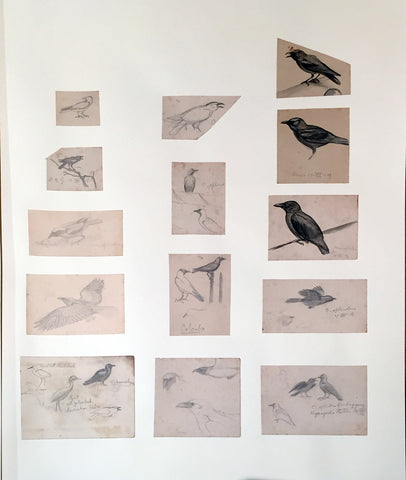Johannes Geradus Keulemans (1842-1912) and Henry Eeles Dresser (1838-1915), A Monograph of the Meropidae, or Family of the Bee-Eaters
Johannes Geradus Keulemans (1842-1912) and Henry Eeles Dresser (1838-1915)
A Monograph of the Meropidae, or Family of the Bee-Eaters
Published by 1884-1886., 1886
Folio (18 4/8 x 15 4/8 inches).
34 fine watercolors, signed by the artist J.G. Keulemans, painted on card and set within window mounts.
Bound for the author in a fine binding of full red morocco gilt, with the title and Dresser's gilt crest stamped in gilt on the front cover, all edges gilt.
This is a superb set of watercolors by one of the finest artists of ornithology, John Gerard Keulemans.
"The Meropidae" was published by the author in five parts between 1884 and 1886. The descriptive text of 144 pages by Dresser also included introductory notes by Frank E. Beddard mainly on the anatomy of the species. An important monograph, "The Meropidae" is one of three major monographs published by Dresser. The others include "History of the Birds of Europe" 1871-1896, still the largest and most complete work on this subject, and "A Monograph of the Coraciidae", 1893.
All of these works contain illustrations by Keulemans. Dresser was also the author of over 100 scientific papers on birds, mostly concerned with geographical distribution and new species. His "Manual of Palaearctic Birds" (1902) was an important contribution to the delimitation of the ranges of Palaearctic birds.
The artist of these fine watercolors, Johannes Gerardus Keulemans (1842-1912), began his career as a taxidermist providing stuffed birds to the State Museum of Natural History at Leiden. The director of that museum encouraged Keulemans to pursue his love of natural history, where he obtained a scientific appointment after an expedition to West Africa in 1865 and 1866.
His accomplishments in illustration came to the notice of Richard Bowdler Sharpe, later a director of the British Museum, who encouraged him to move to England. Keulemans quickly achieved wide recognition and established himself as the most popular bird artist of the late Victorian period. He regularly provided illustrations for "The Ibis" and "The Proceedings of the Zoological Society". He illustrated many important bird books as well as those by Dresser, including Buller's "A History of the Birds of New Zealand" (1873), Shelley's "Monograph of the Sun-Birds" (1876-1880), William Vincent Legge's "Birds of Ceylon" (1880), Daniel Giraud Elliot's "Monograph of the Hornbills" (1887-1892), Richard Bowdler Sharpe's "Monograph on Kingfishers" (1868-1871), Henry Seebohm's "Monograph on Thrushes" (1902), and Osbert Salvin's "Biologia Centrali-Americana" (1879-1904).
Keulemans has painted remarkable pictures of extinct birds, like the Choiseul Crested Pigeon, Kangaroo Island Emu, Huia, Stephens Island Wren, Hawaii Oo, Hawaii Mamo, Oahu Oo, Guadalupe Petrel, and the Laughing Owl. All these paintings can be seen in the American Museum of Natural History in New York.
A leading figure in ornithological circles Henry Eeles Dresser was elected as a Member of the British Ornithologists' Union in 1865 and served as its secretary from 1882 to 1888. He was also a member and fellow of the Linnean and Zoological societies of London and an honorary fellow of the American Ornithologists' Union. He was a close friend of Professor Alfred Newton, Thomas Littleton Powys, 4th Baron Lilford and of Sir Alfred Russel Wallace. He knew all of the leading ornithologists of the day. He was particularly well-known to European, American and Russian ornithologists. He worked with Alfred Newton on the promotion of a "close time" for British birds, a period, during the 18602, when birds could not be hunted. This early effort aided in the commencement of the bird conservation movement.
In spite of Keulemans' prominence as an ornithologist, this activity had to come second to his business which, from 1870 until 1910, was in the iron business, with premises at 110 Cannon Street in The City. Dresser left England in 1912 in order to live in Cannes for the benefit of his health; he died in Monte Carlo. His collection of birds had been in the Manchester Museum, part of the University of Manchester, since 1899 and was purchased for the museum by JP Thomasson (a Bolton businessman). Dresser's egg collection was acquired by the museum in 1912. The museum also contains some of Dresser's correspondence and diaries.
The Bee-Eaters are a group of near passerine birds in the family Meropidae. Most species are found in Africa but others occur in southern Europe, Madagascar, Australia and New Guinea. They are characterized by richly covered plumage, slender bodies and elongated central tail feathers. All are colorful and have long downturned bills and pointed wings, which give them a swallow-like appearance when seen from afar.
Fine Bird Books p. 72; Nissen IVB 269; Wood p. 324; Zimmer p. 178.
We Also Recommend

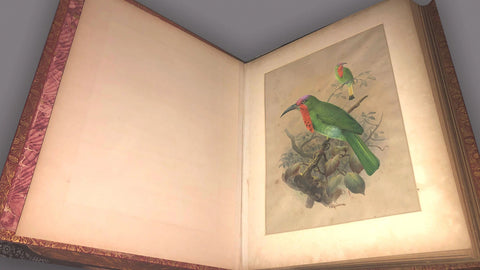

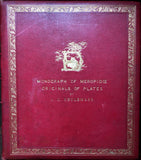
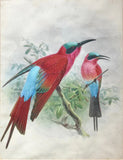

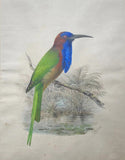
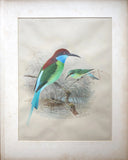
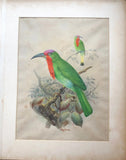
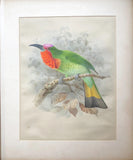
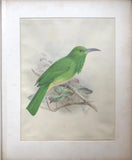


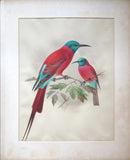




![G. Rauber (German), Gefiedertes Volk [Feathered Folk]](http://aradergalleries.com/cdn/shop/products/rauber_1_large.jpg?v=1623791355)
